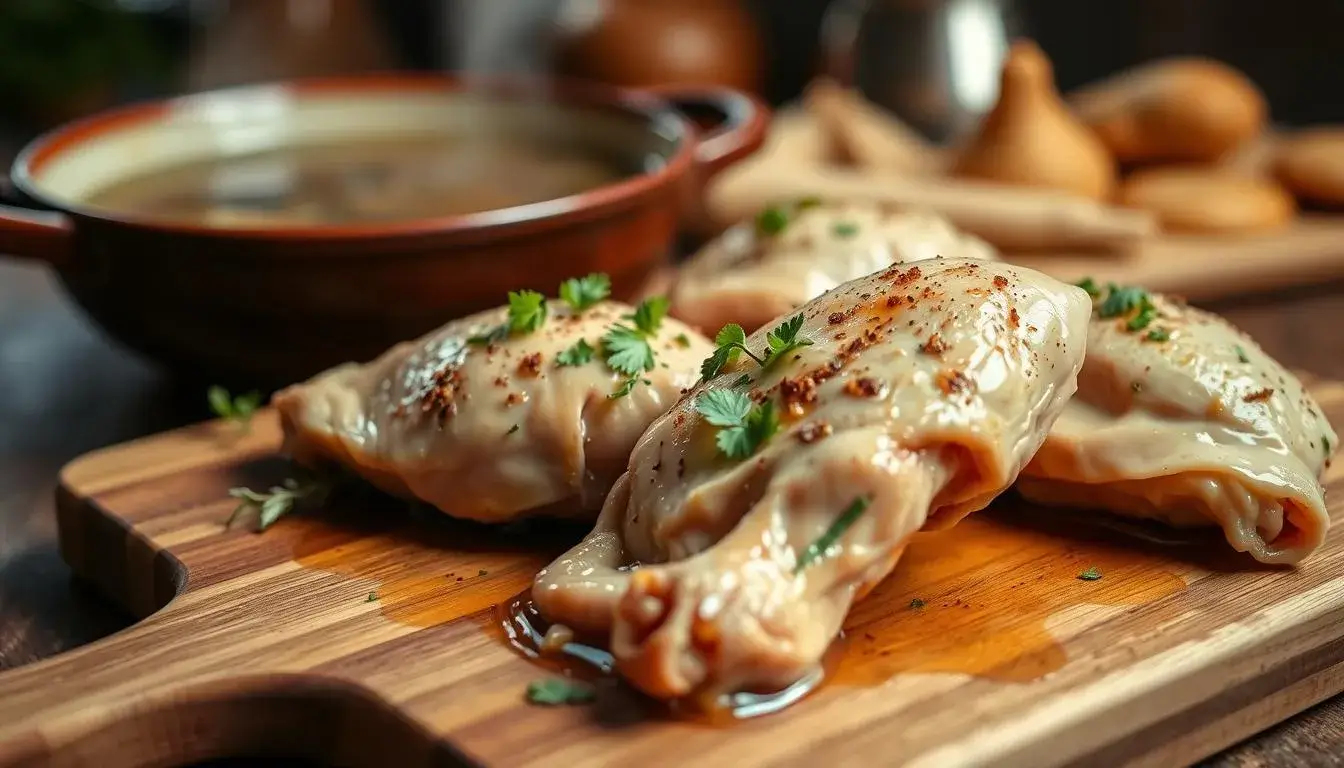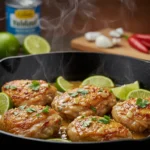Cooking chicken thighs can be tough. My first try was a disaster – it was bland and tough. But after years of practice, I found the secrets to tender, juicy chicken thighs.
Cooking chicken doesn’t have to be scary. This guide will show you how to cook chicken thighs perfectly. It’s great for beginners or anyone looking to get better at cooking.
Boiling chicken thighs is an art. It involves knowing the right temperature, timing, and technique. You’ll learn how to make delicious chicken that’s also healthy and flavorful.
In this guide, you’ll learn everything about boiling chicken thighs. We’ll cover how to choose the best chicken, different cooking methods, and expert tips. These will boost your cooking skills and help you make amazing meals at home.
Table of Contents
Understanding Chicken Thigh Basics and Selection
Choosing the right chicken thighs is key for tasty chicken recipes. Whether boiling or cooking them differently, knowing how to pick chicken can make a big difference.
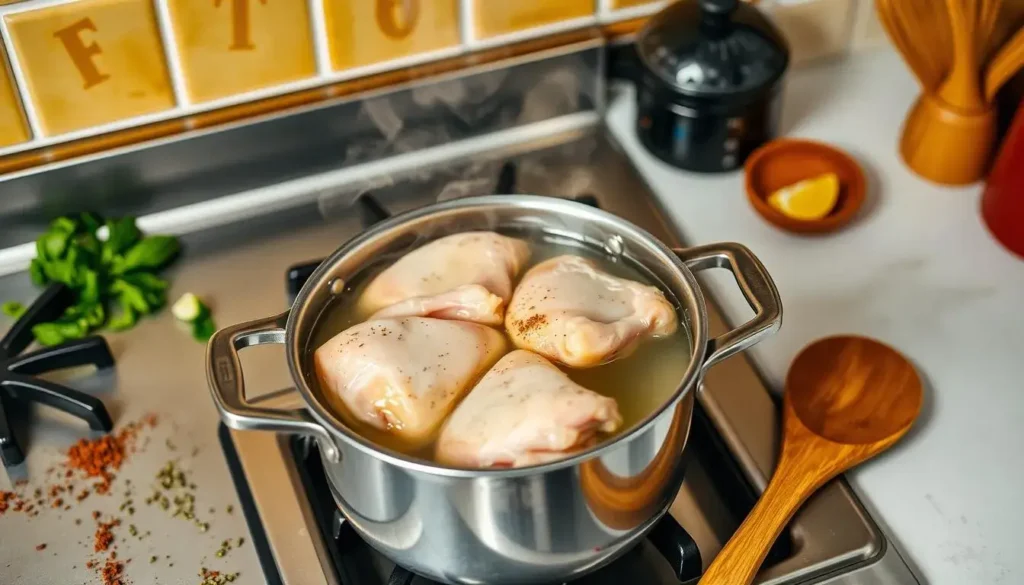
Bone-in vs. Boneless Chicken Thighs
You’ll find two main types of chicken thighs: bone-in and boneless. Each has its own benefits for nutrition and cooking:
- Bone-in thighs taste better and stay moist longer
- Boneless thighs cook quicker and are simpler to eat
- Bone-in thighs usually have more protein
Quality Indicators When Buying Chicken Thighs
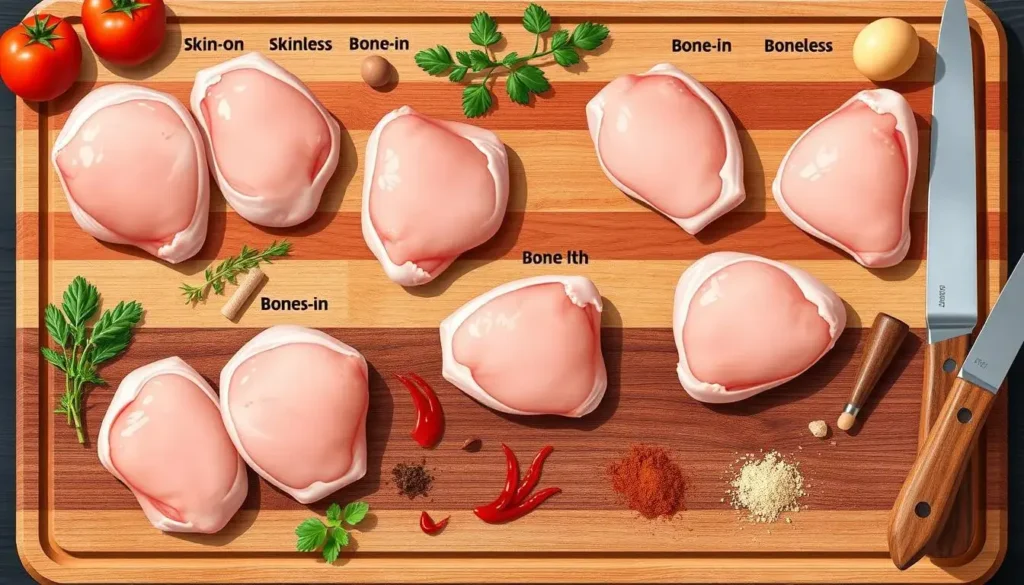
Here are the important signs of quality when buying chicken thighs:
| Quality Indicator | What to Look For |
|---|---|
| Color | Pinkish-white, without gray or yellow discoloration |
| Texture | Firm and moist, not sticky or dry |
| Smell | Minimal odor, fresh and clean |
Fresh vs. Frozen Considerations
Think about the state of your meat when boiling chicken thighs. Fresh chicken thighs have better taste and texture. Frozen thighs are convenient and last longer. Make sure to thaw frozen thighs fully before cooking for even heat and safety.
Choosing between fresh and frozen depends on your time, storage, and cooking plans.
Essential Equipment for Boiling Chicken Thighs
Boiling chicken thighs needs the right kitchen tools for safe and tasty results. The right gear can greatly improve your cooking times and meal prep.
Choosing the right cookware is key for boiling chicken thighs. You’ll need a few important items for a smooth process:
- Large, heavy-bottomed pot with lid
- Digital meat thermometer
- Long-handled cooking tongs
- Cutting board
- Sharp kitchen knife
The pot is your most important tool for boiling chicken thighs. Pick a pot that lets chicken thighs fully submerge with good water flow. A 4-6 quart pot is usually perfect for home cooking.
| Equipment | Purpose in Boiling Chicken Thighs | Recommended Type |
|---|---|---|
| Pot | Primary cooking vessel | Stainless steel, 4-6 quart |
| Thermometer | Checking internal temperature | Digital instant-read |
| Tongs | Handling chicken safely | Stainless steel, 12-inch |
Pro tip: Get a good digital meat thermometer to check cooking times. It makes sure your chicken hits 165°F safely without getting too dry.
Your kitchen tools play a big role in boiling chicken thighs. Good equipment leads to consistent, tender, and safe chicken every time.
How Long to Boil Chicken Thighs: Complete Time Guide
Cooking chicken thighs right takes the right timing and care. Knowing how long to boil them can greatly improve your dishes. Whether you’re making a quick meal or trying new recipes, the cooking time is key.
Different chicken thighs need different cooking methods. The boiling time depends on several things. These include whether the thighs have bones, their size, and their starting temperature.
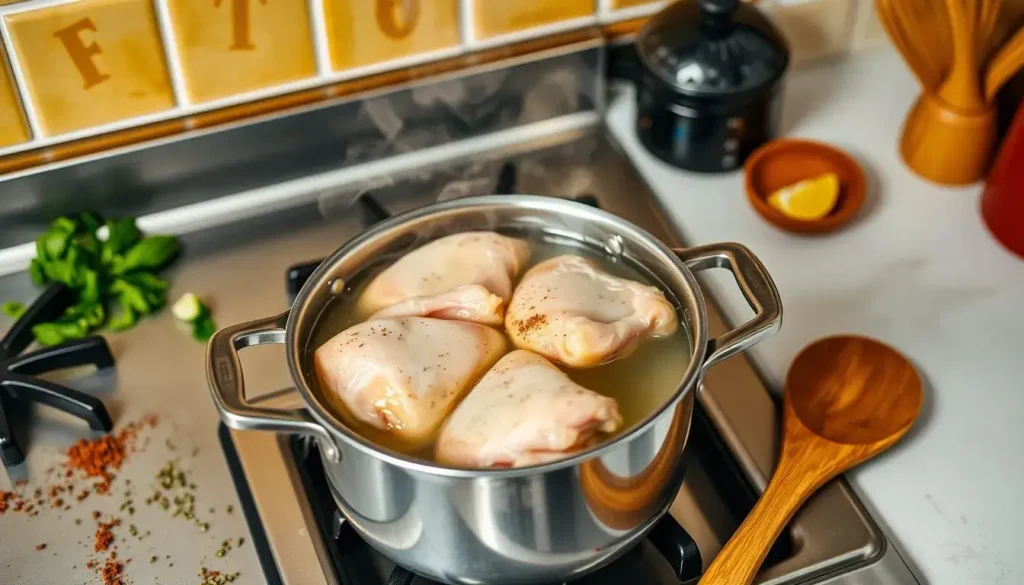
Bone-in Boiling Duration
Boiling bone-in chicken thighs takes longer. Here’s what you need to know:
- 25-30 minutes for medium-sized thighs
- 30-35 minutes for larger thighs
- Ensure internal temperature reaches 165°F
Boneless Thigh Cooking Times
Boneless chicken thighs cook quicker and more evenly. Here’s what you should expect:
- 15-20 minutes of total boiling time
- Check internal temperature reaches 165°F
- Smaller thighs may need slightly less time
Temperature Guidelines for Safe Cooking
Food safety is crucial when cooking chicken thighs. Always use a meat thermometer to verify the internal temperature. The USDA says to cook chicken to 165°F to kill harmful bacteria and ensure it’s safe to eat.
Pro tip: Let chicken rest for 3-5 minutes after cooking. This lets juices spread, making the meat tender and flavorful.
Preparation Steps Before Boiling
Getting your chicken thighs ready for boiling is key. Start by checking your chicken thighs. Make sure they are ready to cook. The right prep can make your chicken dishes stand out.
Here are the essential steps to prepare your chicken thighs:
- Inspect the chicken thighs for any visible fat or unwanted skin
- Rinse the chicken thighs under cold running water
- Pat dry with clean paper towels to remove excess moisture
- Trim any excessive fat using sharp kitchen scissors
For the best boiling chicken thighs, follow these tips:
- Temperature matters: Remove chicken from refrigerator 15-20 minutes before cooking
- Select a pot large enough to allow chicken thighs to cook evenly
- Prepare your seasoning ingredients in advance
Choosing good chicken thighs is important. Look for fresh, plump thighs. Make sure they are moist but not soggy. Check the packaging date too.
Seasoning Options for Flavorful Boiled Chicken
Turning boiled chicken thighs into a tasty dish is all about the right seasoning. When making healthy chicken dishes, the right mix of herbs, spices, and seasonings can make your chicken thigh recipes stand out.
Learning how to season your chicken can turn boiling chicken thighs into a fun cooking experience. Your aim is to add lots of flavor while keeping the meat tender and healthy.
Basic Seasoning Foundations
Begin with these key seasoning mixes for your chicken thigh recipes:
- Salt and black pepper
- Garlic powder
- Onion powder
- Paprika
Herb and Spice Enhancements
Boost your healthy chicken dishes with these flavor enhancers:
| Herb/Spice | Flavor Profile | Best Used With |
|---|---|---|
| Rosemary | Earthy, pine-like | Roasted vegetables |
| Thyme | Minty, slightly lemony | Salads and soups |
| Oregano | Robust, slightly bitter | Mediterranean dishes |
Creating a Flavorful Broth
To make a rich broth when boiling chicken thighs, add:
- Whole peppercorns
- Bay leaves
- Fresh herbs like parsley
- Quartered onions
Pro tip: Your seasoning strategy can transform simple boiled chicken thighs into a dish everyone will love.
Step-by-Step Boiling Process
Boiling chicken thighs needs precision and skill. Start by picking a big pot to fit your meat well. This way, you get tender and juicy chicken every time.
- Prepare the Chicken
- Rinse chicken thighs under cold water
- Pat dry with paper towels
- Remove excess fat if desired
- Select Your Pot
- Choose a heavy-bottomed pot
- Ensure pot has enough space for chicken thighs
- Allow room for water coverage
- Water and Seasoning
- Fill pot with cold water
- Add salt and preferred herbs
- Consider adding aromatics like garlic or onion
Cooking times for chicken thighs depend on whether they’re bone-in or boneless. Bone-in thighs typically require 35-45 minutes, while boneless thighs need about 25-30 minutes of boiling.
| Chicken Thigh Type | Boiling Time | Internal Temperature |
|---|---|---|
| Bone-in Thighs | 35-45 minutes | 165°F |
| Boneless Thighs | 25-30 minutes | 165°F |
When boiling chicken thighs, keep the water simmering gently. This keeps the meat soft and prevents it from becoming tough. Always check the chicken’s internal temperature with a meat thermometer to make sure it’s 165°F.
Signs of Perfectly Cooked Chicken Thighs
Figuring out when chicken thighs are done needs careful watching. Whether you’re trying new recipes or learning cooking times, knowing how to check for doneness is key. It ensures your meal is both safe and tasty.
Visual Indicators of Doneness
Visual signs are helpful when boiling chicken thighs. Look for these important signs:
- Opaque white meat throughout
- No pink or translucent areas
- Consistent color without any reddish tints
Temperature Testing Methods
Measuring temperature accurately is the best way to know if chicken thighs are safe. Use a digital meat thermometer to check the internal temperature:
| Chicken Type | Safe Internal Temperature |
|---|---|
| Bone-in Chicken Thighs | 175°F (79°C) |
| Boneless Chicken Thighs | 165°F (74°C) |
Texture Assessment
The texture of boiled chicken thighs can show if they’re cooked right. Perfectly cooked chicken should feel:
- Firm but not rubbery
- Tender and easy to pull apart
- Moist without being stringy
By mastering these methods, you’ll cook delicious chicken thigh dishes every time.
Common Mistakes to Avoid When Boiling Chicken
Boiling chicken thighs might seem simple, but many mistakes can spoil your dish. Knowing how long to boil chicken thighs and avoiding these errors will help you make delicious, tender meat every time.
When cooking chicken thighs, home chefs often make critical errors that impact the final result. Knowing the right cooking times for chicken thighs can transform your culinary experience.
- Overcooking: The most frequent mistake is boiling chicken thighs too long, resulting in tough, rubbery meat
- Using high heat throughout the cooking process
- Skipping temperature checks
- Not preparing chicken properly before boiling
Let’s explore the key mistakes to avoid during boiling chicken thighs:
| Mistake | Consequence | Solution |
|---|---|---|
| Incorrect Water Temperature | Uneven cooking | Start with lukewarm water, gradually increase heat |
| Not Seasoning | Bland flavor | Add herbs, salt, and pepper before boiling |
| Ignoring Chicken Size | Inconsistent cooking | Choose similar-sized thighs for uniform results |
By avoiding these common pitfalls, you’ll master the art of boiling chicken thighs with perfect texture and flavor.
Storage and Reheating Guidelines
After making tasty chicken thigh recipes, it’s key to store them right. This keeps their flavor and nutrients intact. Knowing how to store and reheat your meals is important for food safety.
When storing boiled chicken thighs, you must be careful. This prevents bacteria from growing and keeps the chicken nutritious. Follow these tips to keep your meal fresh and delicious.
Proper Storage Methods
- Cool cooked chicken thighs completely before storing
- Use airtight containers or sealed plastic bags
- Refrigerate within 2 hours of cooking
- Store in the refrigerator for 3-4 days maximum
Safe Reheating Techniques
Reheating chicken thighs needs to be done carefully. This prevents them from drying out or becoming unsafe to eat. Here are some safe ways to reheat:
- Oven method: Preheat to 350°F, cover with foil
- Microwave: Use medium power, add small amount of liquid
- Ensure internal temperature reaches 165°F
Pro tip: Always check the temperature with a meat thermometer to guarantee safe consumption of your chicken dishes.
Conclusion
Boiling chicken thighs is key to making healthy, tasty meals. It’s easy to do once you know the right times and techniques. You’ll impress everyone with your delicious dishes.
Start by paying close attention to details. Bone-in and boneless thighs need different cooking methods. Always prioritize safety. Learn about temperatures, seasonings, and storage to make your chicken dishes stand out.
Try new herbs, spices, and cooking ways to get better in the kitchen. Whether it’s a quick dinner or a special meal, your skills will help. Enjoy making dishes that are both healthy and delicious.
Keep practicing to get better at boiling chicken thighs. Each recipe you try will make you more confident. Don’t hesitate to try new things and make your recipes unique. Your cooking journey is just starting!
FAQ
How long does it take to boil bone-in chicken thighs?
Bone-in chicken thighs boil in about 35-40 minutes. Make sure the inside reaches 165°F (74°C) for safety. Start by boiling the water, then simmer until the chicken is fully cooked.
Can I boil frozen chicken thighs?
Boiling frozen chicken thighs is not the best idea. Thawing first helps cook more evenly and prevents bacterial growth. If frozen, add 50% more time and use a thermometer to check the temperature.
What’s the best way to add flavor when boiling chicken thighs?
For more flavor, boil chicken thighs in chicken broth instead of water. Add things like peppercorns, bay leaves, garlic, onion, or herbs to the broth. They’ll make the chicken taste richer and more complex.
How do I know when chicken thighs are fully cooked?
Check with a meat thermometer to see if it’s 165°F (74°C) inside. The chicken should be white, with no pink, and the juices should be clear. It should also feel firm but still soft.
Can I use boiled chicken thighs in meal prep?
Yes! Boiled chicken thighs are great for meal prep. Cool them down, then store in an airtight container in the fridge for 3-4 days. They’re good in salads, sandwiches, wraps, or shredded in recipes.
What’s the difference between boiling and poaching chicken thighs?
Boiling uses a full boil, while poaching cooks at a lower temperature (160-180°F). Poaching makes the chicken tender and moist, keeping its texture delicate.
Are boiled chicken thighs healthy?
Boiled chicken thighs can be healthy, especially without the skin. They’re full of protein, vitamins, and minerals, and have less fat than other methods. Just watch the sodium if you add seasonings.
Can I use the liquid from boiling chicken thighs?
Yes! The leftover liquid is like homemade chicken broth. Strain it and use it for soups, sauces, or to cook grains. It’s full of flavor and nutrients from the chicken and any added aromatics.

